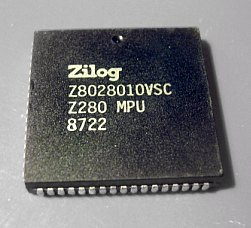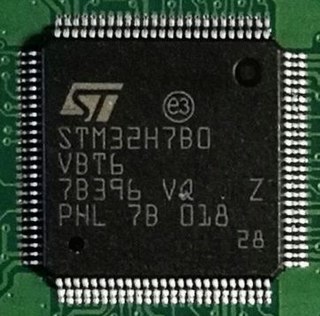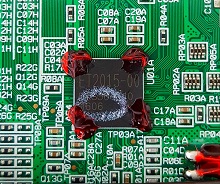
The Intel 8080 ("eighty-eighty") is the second 8-bit microprocessor designed and manufactured by Intel. It first appeared in April 1974 and is an extended and enhanced variant of the earlier 8008 design, although without binary compatibility. The initial specified clock rate or frequency limit was 2 MHz, with common instructions using 4, 5, 7, 10, or 11 cycles. As a result, the processor is able to execute several hundred thousand instructions per second. Two faster variants, the 8080A-1 and 8080A-2, became available later with clock frequency limits of 3.125 MHz and 2.63 MHz respectively. The 8080 needs two support chips to function in most applications: the i8224 clock generator/driver and the i8228 bus controller. It is implemented in N-type metal–oxide–semiconductor logic (NMOS) using non-saturated enhancement mode transistors as loads thus demanding a +12 V and a −5 V voltage in addition to the main transistor–transistor logic (TTL) compatible +5 V.

The Motorola 6809 ("sixty-eight-oh-nine") is an 8-bit microprocessor with some 16-bit features. It was designed by Motorola's Terry Ritter and Joel Boney and introduced in 1978. Although source compatible with the earlier Motorola 6800, the 6809 offered significant improvements over it and 8-bit contemporaries like the MOS Technology 6502, including a hardware multiplication instruction, 16-bit arithmetic, system and user stack registers allowing re-entrant code, improved interrupts, position-independent code and an orthogonal instruction set architecture with a comprehensive set of addressing modes.

The Zilog Z80 is an 8-bit microprocessor designed by Zilog that played an important role in the evolution of early computing. Software-compatible with the Intel 8080, it offered a compelling alternative due to its lower cost and increased performance. The Z80 boasted fourteen registers compared to the 8080's seven, along with additional instructions for bit manipulation, making it a more powerful chip.
In computer architecture, 8-bit integers or other data units are those that are 8 bits wide. Also, 8-bit central processing unit (CPU) and arithmetic logic unit (ALU) architectures are those that are based on registers or data buses of that size. Memory addresses for 8-bit CPUs are generally larger than 8-bit, usually 16-bit. 8-bit microcomputers are microcomputers that use 8-bit microprocessors.

The Intel MCS-51 is a single chip microcontroller (MCU) series developed by Intel in 1980 for use in embedded systems. The architect of the Intel MCS-51 instruction set was John H. Wharton. Intel's original versions were popular in the 1980s and early 1990s, and enhanced binary compatible derivatives remain popular today. It is a complex instruction set computer, but also has some of the features of RISC architectures, such as a large register set and register windows, and has separate memory spaces for program instructions and data.

Zilog, Inc. is an American manufacturer of microprocessors and 8-bit and 16-bit microcontrollers. It is also a supplier of application-specific embedded system-on-chip (SoC) products.

The Intel 8085 ("eighty-eighty-five") is an 8-bit microprocessor produced by Intel and introduced in March 1976. It is the last 8-bit microprocessor developed by Intel.
The Zilog Z800 was a 16-bit microprocessor designed by Zilog and meant to be released in 1985. It was instruction compatible with their existing Z80, and differed primarily in having on-chip cache and a memory management unit (MMU) to provide a 16 MB address range. It also added a huge number of new more orthogonal instructions and addressing modes.

The Zilog Z8000 is a 16-bit microprocessor designed by Zilog in early 1979.

The Zilog Z180 is an 8-bit microprocessor designed by Zilog as a successor to the Z80. It is compatible with the large base of software written for the Z80. The Z180 family adds higher performance and integrated peripheral functions like clock generator, 16-bit counters/timers, interrupt controller, wait-state generators, serial ports and a DMA controller. It uses separate read and write strobes, sharing similar timings with the Z80 and Intel processors. The on-chip memory management unit (MMU) has the capability of addressing up to 1 MB of memory. It is possible to configure the Z180 to operate as the Hitachi HD64180.
The Z80000 is Zilog's 32-bit processor, first released in 1986. It is essentially a 32-bit expansion of its 16-bit predecessor, the Zilog Z8000. It includes multiprocessing capability, a six-stage instruction pipeline, and a 256-byte cache. Its memory addressing system can access 4 gigabytes of RAM. It can execute code written for the Z8000, but is not compatible with the Z80.

The Zilog Z280 is an 16-bit microprocessor designed by Zilog as an enhancement of the Zilog Z80 architecture and integrating improvements from the abandoned Zilog Z800 project. First introduced in July 1987, the Z280 is considered to be a commercial failure.

The 68HC12 is a microcontroller family from Motorola Semiconductor. Originally introduced in the mid-1990s, the architecture is an enhancement of the Freescale 68HC11. Programs written for the HC11 are usually compatible with the HC12, which has a few extra instructions. The first 68HC12 derivatives had a maximum bus speed of 8 MHz and flash memory sizes up to 128 KB.

The Western Design Center (WDC) W65C134S is an 8-bit CMOS microcontroller based on a W65C02S processor core, which is a superset of the MOS Technology 6502 processor.

The Zilog Z80182 is an enhanced, faster version of the older Z80 and is part of the Z180 microprocessor family. It's nicknamed the Zilog Intelligent Peripheral Controller (ZIP).
TLCS is a prefix applied to microcontrollers made by Toshiba. The product line includes multiple families of CISC and RISC architectures. Individual components generally have a part number beginning with "TMP". E.g. the TMP8048AP is a member of the TLCS-48 family.
An MSX-ENGINE chip is a specially developed integrated circuit for home computers that are built according to the MSX specifications. Generally, such a chip combines the functions of many separate, older/simpler chips into one. This is done to reduce required circuit board space, power consumption, and production costs for complete systems.

STM32 is a family of 32-bit microcontroller integrated circuits by STMicroelectronics. The STM32 chips are grouped into related series that are based around the same 32-bit ARM processor core: Cortex-M0, Cortex-M0+, Cortex-M3, Cortex-M4, Cortex-M7, Cortex-M33. Internally, each microcontroller consists of ARM processor core(s), flash memory, static RAM, debugging interface, and various peripherals.
The MSP432 is a mixed-signal microcontroller family from Texas Instruments. It is based on a 32-bit ARM Cortex-M4F CPU, and extends their 16-bit MSP430 line, with a larger address space for code and data, and faster integer and floating point calculation than the MSP430. Like the MSP430, it has a number of built-in peripheral devices, and is designed for low power requirements. In 2021, TI confirmed that the MSP432 has been discontinued and "there will be no new MSP432 products".













